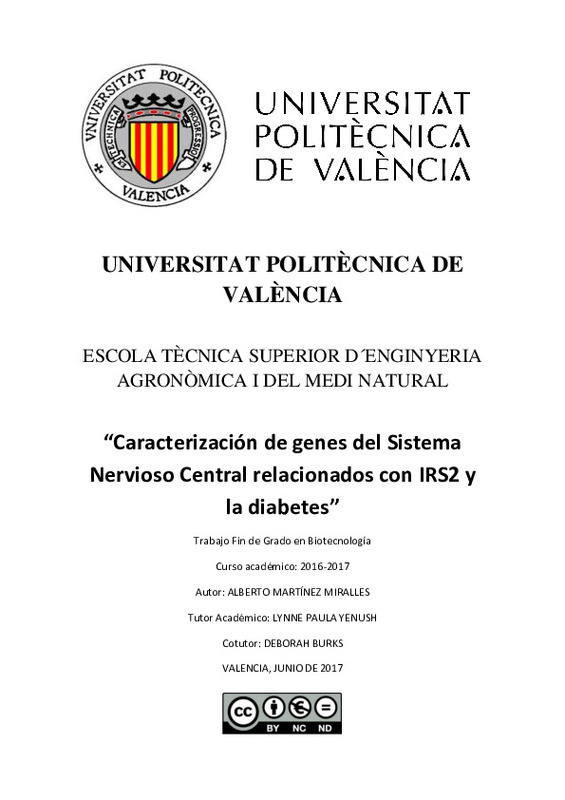|
Resumen:
|
[ES] La diabetes mellitus de tipo 2 es una enfermedad metabólica que se caracteriza por defectos
tanto en la acción de la insulina como en la secreción de insulina. La insulina es una hormona
clave en la regulación del ...[+]
[ES] La diabetes mellitus de tipo 2 es una enfermedad metabólica que se caracteriza por defectos
tanto en la acción de la insulina como en la secreción de insulina. La insulina es una hormona
clave en la regulación del metabolismo energético y de la glucosa en el cuerpo. Actúa
estimulando las células del hígado, músculo y grasa para incorporar la glucosa de la sangre y
almacenarla como glucógeno en el hígado y músculo y además se ha demostrado que juega un
papel clave en otros tejidos como el cerebro donde se ha señalado una posible relación entre
resistencia a insulina y Alzheimer. Los efectos celulares de la insulina están mediados
principalmente por las proteínas IRS (del inglés Insulin Receptor Substrate). Los receptores de
insulina fosforilan y activan las proteínas IRS que actúan como sitios de unión para las distintas
moléculas de señalización que orquestan la respuesta celular a insulina. La familia de las
proteínas IRS está formada por 4 miembros: IRS1, IRS2, IRS3 y IRS4. La forma IRS2 presenta un
determinado dominio que el resto de componentes de la familia no poseen y le permite
interaccionar con el dominio con actividad quinasa del receptor de insulina. Además, IRS2 está
presente en todos los tejidos del organismo humano y de ratón. Los ratones mutantes para
IRS2 (KO) presentan defectos en la señalización por insulina y la masa de las células β del
páncreas disminuye.
La pérdida de IRS2 en ratones provoca un fenotipo diabético caracterizado por machos obesos
y hembras obesas e infértiles. En todos los casos se observa un cerebro de tamaño reducido,
con una disminución del 50% en la proliferación neuronal y un aumento en la
hiperfosforilación de la proteína Tau, marcador de neurodegeneración.
El objetivo principal se basa en determinar si existe alguna relación entre la ausencia de IRS2 y
la expresión de distintos genes en el sistema nervioso central (SNC) relacionados con
patologías neurológicas, estrés oxidativo y apoptosis (Phgdh, Commd9, Atm, Nrf2, etc). Para
ello se analizará el perfil transcripcional de cerebros de ratones wild type y knock out para
IRS2, con el objetivo de definir cambios relacionados con la progresión de la hiperglicemia y
envejecimiento en machos y hembras en este modelo animal de la diabetes tipo 2.
[-]
[EN] Type 2 diabetes mellitus is a metabolic disease characterized by defects in the action of insulin
and the secretion of insulin. Insulin is a key hormone in the regulation of energy metabolism
and glucose in the body. ...[+]
[EN] Type 2 diabetes mellitus is a metabolic disease characterized by defects in the action of insulin
and the secretion of insulin. Insulin is a key hormone in the regulation of energy metabolism
and glucose in the body. It stimulate the liver, muscle and fat cells to incorporate glucose from
the blood and store it as glycogen in the liver and muscle and has also been shown to play a
key role in other tissues such as the brain where has been identified a possible relationship
between insulin resistance and Alzheimer's disease. The cellular effects of the insulin are
mainly mediated by IRS proteins (Insulin Receptor Substrate). Insulin receptors phosphorylate
and activate IRS proteins which act as binding sites for the different signaling molecules that
lead the cellular response to insulin. The family of IRS proteins consists of 4 members: IRS1,
IRS2, IRS3 and IRS4. The IRS2 form presents a specific domain that the other components of
the family do not have and allows it to interact with the domain kinase of the insulin receptor.
In addition, IRS2 is present in all tissues of the human and mouse organism. Mutant mice for
IRS2 (KO) have defects in insulin signaling and the mass of the pancreatic β cells decreases.
The absence of IRS2 in mice causes a diabetic phenotype characterized by obese males and
obese and infertile females. In all cases a small brain is observed, with a 50% decrease in
neuronal proliferation and an increase in hyperphosphorylation of the Tau protein, a marker of
neurodegeneration.
The main objective is to determine if there is any relationship between the absence of IRS2
and the expression of different genes in the central nervous system (CNS) related to
neurological pathologies, oxidative stress and apoptosis (Phgdh, Commd9, Atm, Nrf2, etc.).
The transcriptional profile of brains of wild type and knock out mices for IRS2 will be analyzed,
to define changes related to the progression of hyperglycemia and aging in males and females
in this animal model of type 2 diabetes.
[-]
|







